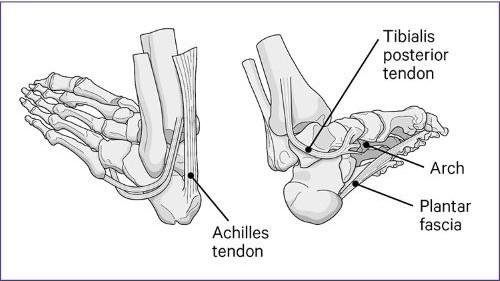Tibialis posterior dysfunction
What is tibialis posterior dysfunction?
Tibialis posterior dysfunction causes pain, redness, warmth and swelling in the tendon running from the inside of the calf to the arch of the foot.
Tendons are strong cords that connect muscle to bones and support the structure and movement of your foot and ankle.

Your ankle may feel weak. It can make walking, standing for long periods, or rising to yout tip toes difficult.
The arch of your foot may become flatter and your heel could tilt outwards. It can feel worse when you are active, particularly if you are running or jumping.
It is caused by inflammation, damage or a weakness which over-stretches the tendon. If left untreated, it can cause long-term damage and changes to the feet which need surgery to correct.
How can I treat tibialis posterior dysfunction?
Tibialis posterior dysfunction can often be treated without the need to see a healthcare professional.
You should feel an improvement in the injury over the first few days of following some simple self-care tips.
Paracetamol and ibuprofen can help reduce the swelling and pain.
Over the first few days you are best to avoid hot baths, heat packs, and drinking alcohol as they can affect healing.
The following self-care tips, known as RICE therapy, should help improve healing:
- Rest – try to avoid putting weight on the injury. Do not exercise, instead try gently moving it from time to time to stop the area getting stiff.
- Ice – put an ice pack or frozen vegetable, covered in a damp cloth, on it for 20 minutes every 2–3 hours.
- Compression – wrap a bandage around the painful area. It should be tight enough to support it, but not so tight that it restricts blood flow.
- Elevate your foot to reduce swelling.
We suggest you see a doctor, podiatrist or physiotherapist if you think you might need a splint or support for the ankle or arch of the foot.
Once it is less painful, exercises to stretch the calf muscle and strengthen the tendon should help. However, it may take several months of self-care treatment before it recovers fully. If the pain is severe or has not improved after two weeks following the self-management tips, speak to one of the healthcare professionals mentioned above.
Because the tibialis posterior tendon runs close to the Achilles tendon this condition can sometimes be confused with Achilles tendinopathy.
You can find exercises to strengthen and support your foot and ankle on our foot and ankle pain page.